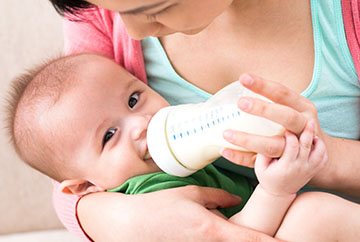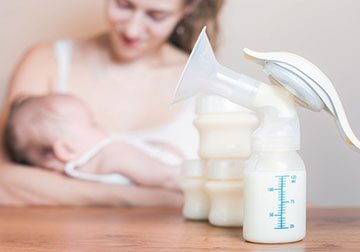A young mother may not be familiar with all the intricacies of breastfeeding, so at the first stage of motherhood many difficulties associated with feeding and lactation may arise.
Believe me, these are temporary problems that can be avoided by keeping calm and common sense. Very soon you will learn to understand your baby’s wishes without words, but for now, be patient!
Now let's look at this in more detail.
So how to increase the amount of breast milk during breastfeeding, what foods increase lactation in a nursing mother? Let's find out from our article.
Signs that your baby is not getting enough breast milk
Don't try to estimate how much breast milk you produce. It is better to pay attention to signs that indicate that the baby has enough milk. Try asking yourself the following questions:
- Is your baby gaining weight?
One of the most reliable signs of proper feeding is the child’s stable weight gain. It is worth noting that most often newborns lose a little weight in the first few years of life (but no more than 10% of birth weight), but regain it by the 10th day of life. A growth chart along with consultation with a doctor will help you monitor your baby's development.
- Does a baby need a lot of diapers?
Count how many newborn diapers you use. This is a good indicator of whether your baby is getting enough food. Typically, a child needs to change six wet diapers per day, and at least three or four of them should be with stool. In the first days, a newborn's stool is dark and sticky, but later becomes liquid and yellowish. Urine should be pale yellow and odorless, not dark yellow or orange.
- How often does your baby breastfeed?
Newborns are breastfed 8 to 12 times a day, approximately every two to three hours. Nutritional requirements may increase during growth spurts.
- Does your baby seem happy between feedings?
If after feedings the baby looks satisfied, happy, cheerful and active (and not nervous and capricious), most likely he has enough nutrition.
- Are your skin and lips dry?
If there are no signs of dehydration, the lips are moist and not chapped, and the fontanelle is not sunken, then most likely the baby is getting enough fluids from the mother's milk.
If your baby doesn't get enough milk, he may sleep all the time or appear sleepy. In this case, be sure to contact your pediatrician.
Warm shower before feeding
If you have problems with lactation, experts advise taking a warm shower.
The benefits of this procedure are as follows:
- Water helps to relax the body, which makes it easier for milk to flow out.
- Light breast massage can increase milk flow.
- A warm shower helps not only with a lack of milk, but also with its stagnation.
- The sound of water affects the brain receptors, which are responsible for the production of hormones that trigger the process of milk formation.
It is enough to stand in a warm shower for a few minutes before feeding. This water procedure is also useful when a woman needs to express milk.
What affects the amount of breast milk?
If your baby isn't getting enough nutrition, it's most likely because he's not latching on properly, not because you're not producing enough milk. Read how to help your baby latch on correctly. But there are other factors due to which the amount of breast milk decreases:
- You started breastfeeding late (ideally, you can breastfeed your baby immediately after birth, but in some cases this is not possible).
- You are not breastfeeding often enough (experts recommend putting your baby to the breast on demand in the first month of life, but at least 8–12 times a day).
- You are taking certain medications, including those containing pseudoephedrine, or certain types of hormonal contraceptives that reduce milk production.
- The baby does not latch onto the breast correctly, which reduces milk production.
- You had breast surgery.
- The child was born prematurely.
- You have pregnancy-induced hypertension.
- You are overweight or obese.
- You have insulin-dependent diabetes.
Establishing breastfeeding after cesarean
There is another side to the issue when the mother gave birth by cesarean section. It is known that after surgical treatment, the mother is in intensive care under the supervision of doctors and there can be no talk of staying together with the baby. The baby quickly gets used to the first bottle feeding and here you just need to be patient and help the baby get used to the new form and method of feeding - the mother's breast.

There are cases when surgical birth occurs due to a threat to the baby’s life, babies are born premature, they are not so strong to suck out mother’s milk and bottle feeding is even better, but in this case it is better to feed him after breastfeeding.
This is done in order to stimulate the production of prolactin; as a rule, the baby will not be satisfied due to his weakness, but will help the mother preserve milk for the future. But after the baby gets stronger, he will be able to fully suck milk from his mother’s breast.
How to increase lactation
There is nothing to worry about - the amount of breast milk can always be increased. Here are some ways:
- Start breastfeeding as early as possible.
If possible, try to breastfeed your baby immediately, within the first hour of life. But sometimes this is not possible - for example, after a caesarean section. Don't worry, there are other ways to increase lactation!
- Use your breast pump regularly.
The more milk you express, the more milk you will produce. If you go to work, express milk for 15 minutes every few hours. To save time, you can use a double breast pump, with which you can express both breasts at the same time.
- Breastfeed frequently.
Typically, babies need 8 to 12 feedings per day. The more often your baby nurses and the more often you use your breast pump between feedings, the more milk you will produce.
- Make sure your baby is latching on correctly.
It is important that your baby latch on to the breast and swallow milk correctly. If in doubt, talk to a lactation consultant or doctor to assess whether your baby is latching correctly and swallowing well.
- Feed from both breasts.
Remember to switch breasts during feedings, offering a different breast each subsequent feeding. Both breasts must be involved in milk production. Use a breast pump to express any accumulated milk.
- Don't skip feedings.
Stick to your feeding schedule. If you work while breastfeeding and are pumping, try not to skip pumping as this will affect your milk supply.
- Consult your doctor about medications.
Some medications reduce lactation. Consult your doctor - perhaps he will advise you on analogues that do not affect the production of breast milk.
- Talk to a lactation consultant.
If you still think your milk supply is low, talk to a lactation specialist or your doctor.
No need to worry! Even if you feel like you don't have enough breast milk, there are ways to increase your milk supply. Follow our advice and consult with your doctor to find out for sure whether your baby is getting enough nutrition.

Skin to skin contact

To restore lactation, it is important to establish a continuous and close contract between mother and child, to ensure the continuation of the unity that he experienced while in the womb.
The duration of breastfeeding depends on whether there was skin-to-skin contact immediately after the birth of the baby.
The question arises, how long should you keep your baby at your breast?
Many people believe that the child gets full within the first 10-15 minutes, and then begins to indulge. And for this reason, parents limit the time they suck. This is not worth doing, because being next to the mother, feeling her breath, the baby enjoys, calms down, and warms up. This allows not only to improve lactation, but also to maintain communication physically and emotionally.
Skin-to-skin contact is especially important if the baby was born by caesarean section. At the moment of contact, a woman is more sensitive to the hormone oxytocin, which is responsible for maternal instinct.
WHO opinion: nutrition and increasing lactation levels
The World Health Organization, which strongly supports natural feeding and its promotion, does not provide specific guidance regarding the nutrition of a nursing mother. The documents only say that a nursing woman should eat a balanced diet, get all types of foods and a sufficient amount of calories. In order for the lactation process to occur correctly and not deplete the body, a woman needs an additional 500 kilocalories per day, above the “norm”. There are many ways to calculate your own calorie intake, but according to average data, a woman from 26 to 50 years old needs 2200 kcal per day. This means that during the feeding period this figure should tend to 2700 kcal. By practicing rational and healthy nutrition, a woman will be able to maintain lactation for as long as needed.
How to cook rolled oats
Hercules with milk is an old recipe known to our grandmothers. It's quite simple to prepare:
- One part of water is mixed with 3 parts of milk; it is better to take goat milk, as it is much closer in composition to human milk.
- There should be approximately 1 cup of liquid. For this volume, take 1 tablespoon of rolled oatmeal flakes ground in a coffee grinder.
- All this should be placed in a saucepan and boiled for 20 minutes.
Rolled oats with milk will be beneficial for the gastrointestinal tract because it contains fiber and protein.
Tasty and healthy - let's talk about the benefits of watermelons
Natural resources are available in every season. For example, in summer and autumn you can see fruit and berry crops such as watermelons on the market. Their varieties are diverse, but they bring the same benefits - they saturate with vitamins and help remove toxins from the body.
Almost every woman is interested in whether nursing mothers can drink watermelon? An assessment of the condition of the body, the presence or absence of allergies in the mother and child, and the high quality of the product itself will help answer this question.
Doctors usually recommend conducting research on the suitability of watermelon at home. To do this, take a glass of water and dip a piece of pulp into it. If the water becomes cloudy, then it is a bad product and should not be eaten. If the water turns pink after two hours, then you have chosen a high-quality watermelon.

Nursing mothers should understand that the described berry has a large amount of pulp, in which harmful and dangerous bacteria quickly multiply. If a ripe fruit lies next to a rotten product, then pathogenic microorganisms can enter it, and thanks to this, the best watermelon can turn into a health hazard.
In addition, in the first months of feeding, you should not eat this berry, so as not to cause allergies in the child. The risk of poisoning is quite high, and therefore watermelon is most often not recommended for nursing mothers.

Canceling additional fluids for a newborn

Many mothers believe that breast milk is food. And they feed the baby with plain water.
This is strictly forbidden for the following reasons. Human milk contains only 12% nutrients, its main component being water.
Therefore, until the age of six months, there is no need to give additional water to the child, unless there is a medical indication for this.
Giving water to a baby is also dangerous. This creates a feeling of false satiety in the baby; he does not receive enough nutrients, which can affect his health, development and weight gain. Supplementation can lead to disruption of the baby's digestive system, and it also puts additional stress on the kidneys.
The composition of breast milk at the beginning and at the end of feeding is not the same. First, the child receives lactose, and then lactase. This enzyme supports the breakdown of lactose and promotes its absorption. If you give your baby extra water or express after feeding, he will not receive enough of the necessary substances, which will lead to indigestion. In most cases, this is what causes colic in the tummy of a baby.
Ignorance of these features contributes to the spread of the opinion that the mother’s milk is bad or that the baby has lactose intolerance.
When drinking mother's milk, the baby eats and drinks at the same time, so additional feeding with water is simply not required. But this is true for those children who are breastfed.
The situation is different for babies who are bottle-fed. Babies receiving formula should be given clean water between feedings. This is especially important in cases where children are fed an unadapted or overly concentrated formula.
How to take tea
Before drinking the drink, you should prepare it in the simplest and most accessible way. To do this, brew 3-4 teaspoons or 1 tea bag with hot water in a 200-250 ml cup. After this you can drink it. The number of cups per day can be up to four. To increase lactation, you should drink tea 20 minutes before feeding.
Drinking the described drink helps improve the condition of a nursing woman’s body and has a beneficial effect on the nervous system, thereby establishing natural processes in the body. In addition, milk contains substances that eliminate colic in the newborn’s intestines.
The calmer the mother, the calmer the baby, so it is necessary to find products that will contribute to this condition. One such product is Hipp tea. One package can last for a week or two, depending on how much of this drink you drink per day.
No pumping

Expressing milk after each feeding provokes more milk production. Whether this procedure is necessary is currently a controversial issue.
If the mother feeds the baby on demand, there is no need for regular pumping.
On the contrary, with sufficient breast stimulation, the woman’s body itself “understands” how much milk needs to be produced for feeding.
Expressing breast milk disrupts the body's receipt of correct information . By the next feeding, a larger amount will be produced, which the baby will not be able to handle. This can cause stagnation of milk in the breast, which increases the risk of developing inflammatory processes in the mammary glands.
Expression should be used in the following cases:
- hardening of the nipples;
- mastitis;
- cracks;
- weakened baby;
- premature baby;
- forced separation from the baby.
Pumping will allow you to supplement your weak baby, who quickly gets tired and falls asleep during feeding, with breast milk without replacing it with artificial formula. After the child gets stronger, you can abandon this procedure.











